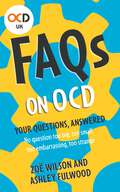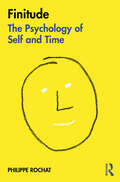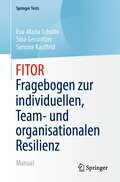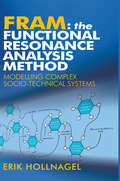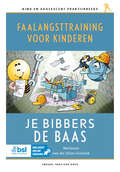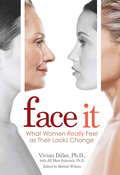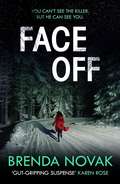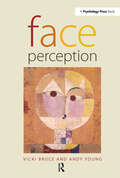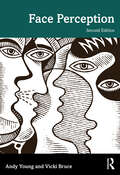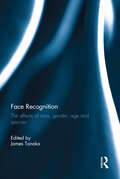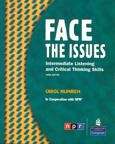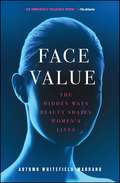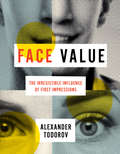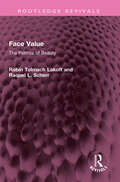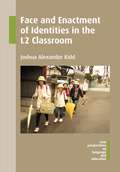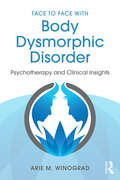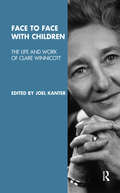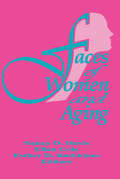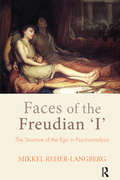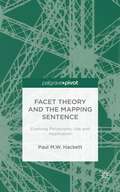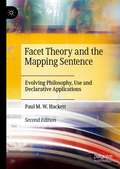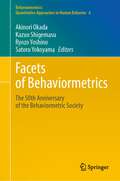- Table View
- List View
FAQs on OCD
by Ashley Fulwood Zoe WilsonFOREWORD BY PROFESSOR PAUL SALKOVSKIS- You left the doctor's surgery before you could ask the things you really wanted to know.- You've googled your question about OCD and had 75 answers, all contradicting each other.- You asked your best friend - but they looked at you strangely.You have so many questions, but no idea where to start finding the answers. Here they are. In this book you'll find the definitive, expert responses to all your FAQs: On OCD. No question is too simple, too embarrassing, too rude or too offbeat to be included, and each one has been asked by thousands of people just like you.Will people judge me for my thoughts?Can hormones make OCD worse?Does anyone ruminate as much as me?All these questions, and hundreds more, are covered in this short but powerful, helpful, practical guide to managing your OCD. Read at your leisure, or dip in and out when you most need the support or to shine a light on the thoughts and feelings that are making you uncomfortable or unhappy, and to bring them out of the shadows so you can understand and accept them.
FAQs on OCD
by Ashley Fulwood Zoe WilsonFOREWORD BY PROFESSOR PAUL SALKOVSKIS- You left the doctor's surgery before you could ask the things you really wanted to know.- You've googled your question about OCD and had 75 answers, all contradicting each other.- You asked your best friend - but they looked at you strangely.You have so many questions, but no idea where to start finding the answers. Here they are. In this book you'll find the definitive, expert responses to all your FAQs: On OCD. No question is too simple, too embarrassing, too rude or too offbeat to be included, and each one has been asked by thousands of people just like you.Will people judge me for my thoughts?Can hormones make OCD worse?Does anyone ruminate as much as me?All these questions, and hundreds more, are covered in this short but powerful, helpful, practical guide to managing your OCD. Read at your leisure, or dip in and out when you most need the support or to shine a light on the thoughts and feelings that are making you uncomfortable or unhappy, and to bring them out of the shadows so you can understand and accept them.
FINITUDE: The Psychology of Self and Time
by Philippe RochatPhilippe Rochat’s FINITUDE is a rumination on time and self-consciousness. It is built around the premise that finitude and separation form the human self-conscious reality of time. It argues that we need to reclaim time from current theories in physics that tend to debunk time as an illusion, or state that time simply does not exist. This thought-provoking book considers how, from a human psychological and existential standpoint, time is very real. It examines how we make sense of such reality in human development and in comparison to other living creatures. The book explores how we represent time and live with it. It tries to capture the essence of time in our self-conscious mind. If we opt to live for as long as possible and knowing that it is going to end, how should we exist? FINITUDE contemplates this most serious psychological question. It considers the developmental origins of human subjectivity, the foundations of our sense of being alive and the explicit awareness of existing in finite time. It deals with how we live and represent our finite time, how we construe and archive in memory the events of our life, how we project ourselves into the future, and how we are all constrained to knowingly exist in finite time Offering an overarching understanding of concepts, above and beyond the methodological details, this book will be an essential reading for all advanced students and researchers interested in the psychology of time, and the development of self.
FITOR - Fragebogen zur individuellen, Team und organisationalen Resilienz: Manual (SpringerTests)
by Simone Kauffeld Eva-Maria Schulte Sina GessnitzerFITOR (Fragebogen zur individuellen, Team und organisationalen Resilienz): Dieser Fragebogen erfasst die Resilienz – das Vermögen, Misserfolge, Rückschläge oder andere potentiell bedrohliche Situationen erfolgreich zu überwinden – auf Ebene des Individuums-, des Teams- und der Organisation. Autoren: Dr. Eva-Maria Schulte, Dr. Sina Gessnitzer, Prof. Dr. Simone Kauffeld Die internen Konsistenzen der reduzierten Skala lagen sowohl für die individuelle Ebene (Studie 1: α = 0,84; Studie 2: α = 0,82), als auch für die Team- (Studie 1: α = 0,93; Studie 2: α = 0,94.) und die organisationale Ebene (Studie 1: α = 0,92; Studie 2: α = 0,92) im guten bis sehr guten Bereich (Kline 1999). Konvergente Validierung anhand unterschiedlicher Skalen je Ebene z.B. Validierungsskalen der individuellen Ebene: Individuelle Selbstwirksamkeit Validierungsskalen der Teamebene: Selbstwirksamkeit im Team Validierungsskalen der organisationalen Ebene: Organisationsklima Da der FITOR auf drei Ebenen (Individuum, Team, Unternehmen) ausgewertet werden kann, müssen wir uns hier mit den Autorinnen kurzschließen, aber die sind ja in direkter Nähe… ich würde es als Gruppenverfahren ähnlich wie den SPA sehen: Mindestanzahl Teilnehmende bevor ich Ergebnisse sehen kann. Die Individual- und Teamitems könnten als Mittelwerte pro Team ausgewertet werden. Um ein sinnvolles Ergebnis für ein ganzes Unternehmen zu bekommen, könnte eine Funktion zum Aggregieren mehrerer Gruppenergebnisse implementiert werden. Allerdings ist hier auch die Frage, ob ich die Unternehmensitems auch aus Sicht des Teams als Mittelwert nutzen kann – „Was denkt das Team über die Unternehmens-Reslizienz“? Wenn das möglich ist, wäre es vermutlich ein „reines“ Standardverfahren analog zum SPA. Weitere Möglichkeiten ohne eine konkrete technische Umsetzung im Kopf zu haben: Die Teilnehmenden bekommen nach dem Ausfüllen einen Individual-Report als PDF zugeschickt (bzw. angezeigt, wenn sie keine Mail Adresse haben). So hätten wir auch eine individuelle Auswertung, ohne dass eine Führungskraft Einzelergebnisse sieht.
FND Stories: Personal and Professional Experiences of Functional Neurological Disorder
by Gregg H. Rawlings, Markus Reuber, Jon Stone and Maxanne McCormickFunctional Neurological Disorder (FND) is one of the most common diagnoses among patients referred to neurology clinics, but is still misunderstood and under-recognised by medical professionals and the public. This vital book brings together the voices of healthcare professionals and people living with FND across the world. Experts in neurology provide a clear, evidence-based explanation of FND as an introduction, laying the foundation for the personal stories of people with FND and the professionals involved in their care. From testing and diagnosis to dealing with stigma and coping with changing symptoms, each chapter delves into the realities of life with FND from the perspective of lived experience. FND can be an isolating condition. The life stories in this book will help you to make sense of living with FND and tackle its challenges alongside others with the condition.
FRAM: Modelling Complex Socio-technical Systems
by Erik HollnagelResilience engineering has consistently argued that safety is more than the absence of failures. Since the first book was published in 2006, several book chapters and papers have demonstrated the advantage in going behind 'human error' and beyond the failure concept, just as a number of serious accidents have accentuated the need for it. But there has not yet been a comprehensive method for doing so; the Functional Resonance Analysis Method (FRAM) fulfils that need. Whereas commonly used methods explain events by interpreting them in terms of an already existing model, the FRAM is used to model the functions that are needed for everyday performance to succeed. This model can then be used to explain specific events, by showing how functions can be coupled and how the variability of everyday performance sometimes may lead to unexpected and out-of-scale outcomes - either good or bad. The FRAM is based on four principles: equivalence of failures and successes, approximate adjustments, emergence, and functional resonance. As the FRAM is a method rather than a model, it makes no assumptions about how the system under investigation is structured or organised, nor about possible causes and cause-effect relations. Instead of looking for failures and malfunctions, the FRAM explains outcomes in terms of how functions become coupled and how everyday performance variability may resonate. This book presents a detailed and tested method that can be used to model how complex and dynamic socio-technical systems work, to understand why things sometimes go wrong but also why they normally succeed.
Faalangsttraining voor kinderen: Je bibbers de baas (Kind en adolescent praktijkreeks)
by Marianne van der Zalm-GrisnichDit boek is een cognitief gedragstherapeutisch (groeps)behandelprotocol waarmee therapeuten kinderen tussen de 9 en 12 jaar leren met hun faalangst om te gaan en deze te verminderen. Dit protocol is door het NJI erkend als ‘goed onderbouwde jeugdinterventie’ en geschreven voor orthopedagogen, kinderpsychologen, gedragstherapeuten en psychotherapeuten. Deze tweede, herziene versie van Je bibbers de baas combineert cognitieve gedragstherapie met ontspanningstechnieken, psycho-educatie en onderdelen uit de Acceptance and Commitment Therapy. Ook komt de rol van mindset aan bod. Verder zijn energizers toegevoegd en is er aandacht voor terugvalpreventie. Ook bevat de handleiding nu een hoofdstuk over gebruik in bijzondere situaties, zoals het voortgezet onderwijs, klassikaal gebruik, individuele inzet en gebruik bij kinderen met ontwikkelingsproblemen. Het protocol bestaat uit tien kinderbijeenkomsten en twee ouder- en leerkrachtbijeenkomsten. Kinderen werken in hun eigen werkboek (apart verkrijgbaar). Voor ouders en leerkrachten is er een online werkboek. Deze en meer online materialen zijn toegankelijk met behulp van een code in de handleiding.
Face It: What Women Really Feel As Their Looks Change
by Vivian DillerLet’s face it: everyone’s getting older. But millions of women, raised to believe that success and happiness are based on their intelligence and accomplishments, face an unexpected challenge: the physical realities of aging. If looks are not supposed to matter, why do so many women panic as their appearance changes? Their dilemma stems from two opposing societal views of beauty which lead to two different approaches to aging. Should women simply grow old naturally since their looks don’t define them, or should they fight the signs of aging since beauty and youth are their currency and power? This Beauty Paradox leaves many women feeling stuck. Face It, by Vivian Diller, Ph.D., is a psychological guide to help women deal with the emotions brought on by their changing appearances. As a model turned psychotherapist, Diller has had the opportunity to examine the world of beauty from two very different vantage points. This unique perspective helped her develop a six-step program that begins with recognizing "uh-oh" moments that reveal the reality of changing looks, and goes on to identify the masks used to cover deeper issues and define the role beauty plays in a woman’s life, and ends with bidding adieu to old definitions of beauty, so women can enjoy their appearance—at any age!
Face Off (Evelyn Talbot)
by Brenda NovakNew York Times bestseller Brenda Novak's third novel in the Evelyn Talbot series sees the return of psychiatrist Dr Evelyn Talbot in her purpose-built facility housing America's most terrifying psychopaths. This is SILENCE OF THE LAMBS meets Karen Rose...Over twenty years ago, Dr Evelyn Talbot was scarred for life when her teenage boyfriend Jasper Moore tortured her and left her for dead. And she fears one day he will return to finish what he started.Evelyn has tried to move forward and turned her trauma into her life's work. As a leading psychiatrist at Hanover House in remote Alaska, she is confronted with psychopaths and danger every day. She delves deep into their minds, despite the horrors that hide there, trying to figure out why they do what they do.When a woman goes missing from a nearby cabin, Evelyn immediately believes one of the Hanover House killers might be involved. But something about the case brings familiar and terrifying memories back to haunt her. She fears the truth may be closer, and darker, than she first imagined.
Face Perception
by Vicki Bruce Andy YoungHuman faces are unique biological structures that convey a complex variety of important social messages. Even strangers can tell things from our faces – our feelings, our locus of attention, something of what we are saying, our age, sex and ethnic group, whether they find us attractive. In recent years there has been genuine progress in understanding how our brains derive all these different messages from faces and what can happen when one or other of the structures involved is damaged. Face Perception provides an up-to-date, integrative summary by two authors who have helped develop and shape the field over the past 30 years. It encompasses topics as diverse as the visual information our brains can exploit when we look at faces, whether prejudicial attitudes can affect how we see faces, and how people with neurodevelopmental disorders see faces. The material is digested and summarised in a way that is accessible to students, within a structure that focuses on the different things we can do with faces. It offers a compelling synthesis of behavioural, neuropsychological and cognitive neuroscience approaches to develop a distinctive point of view of the area. The book concludes by reviewing what is known about the development of face processing and re-examines the question of what makes faces ‘special’. Written in a clear and accessible style, this is invaluable reading for all students and researchers interested in studying face perception and social cognition.
Face Perception
by Vicki Bruce Andy YoungHuman faces are unique biological structures that convey a complex variety of important social messages. Even strangers can tell things from our faces – our feelings, our locus of attention, something of what we are saying, our age, sex, and ethnic group, whether they find us attractive or approachable. Face Perception, second edition, has been thoroughly updated throughout, providing an up-to-date, integrative summary by two authors who have helped to develop and shape the field. The book begins with the foundations of face perception before considering what is known about how we see different things in faces. It concludes with a discussion of how face perception relates to wider questions involving interpersonal perception and re-examines the question of what makes faces ‘special’. The importance of integrating different research perspectives and asking critical theoretical questions is emphasised throughout, to develop a distinctive point of view of the area. Written in a clear and accessible style, this is invaluable reading for all students and researchers interested in studying face perception and social cognition.
Face Recognition: The Effects of Race, Gender, Age and Species
by James TanakaAlthough most people are good at face recognition, we are particularly good at recognizing the faces of individuals who share our race, gender, age and species. What factors might account for this type of bias in face recognition? This collection considers the issue of how our identity influences the type of perceptual experience that we have to faces, which, in turn, influences the processes of face recognition. Leading experts from cognitive psychology, neuroscience and computer science address a wide range of topics related to the neural and computational basis of the "own versus other" effect in face recognition, the impact of early experience in infant face recognition, the effect of laboratory training to reverse the other-race effect, cultural differences in expression recognition and the forensic and social consequences of "own versus other" face recognition. The combined work gives the reader a comprehensive overview of the field and an insider’s perspective on the role that identity and experience play in the everyday process of face recognition.This book was originally published as a special issue of Visual Cognition.
Face The Issues: Intermediate Listening And Critical Thinking Skills
by Carol Numrich National Public Radio (U.S.) StaffFace the Issues: Intermediate Listening and Critical Thinking Skills, Third Edition, by Carol Numrich, in cooperation with NPR®, helps intermediate students develop critical thinking skills as they gain insight into American attitudes and values. Each thought-provoking unit is based on an authentic radio broadcast from National Public Radio®. Students develop essential listening strategies such as predicting, looking at language, understanding main ideas and points of view, and focusing on details. Language and concepts are integrated through follow-up critical thinking activities including discussion, debate, values clarification, survey, role play, case study, inteview, and simulation.
Face Value: The Hidden Ways Beauty Shapes Women's Lives
by Autumn Whitefield-MadranoA thought-provoking examination of how we think and talk about beauty today--and the unexpected and often positive ways that beauty shapes our lives.For decades, we've discussed our insecurities in the face of idealized, retouched, impossibly perfect images. We've worried primping and preening are a distraction and a trap. But have we focused too much on beauty's negative influence? In Face Value, journalist Autumn Whitefield-Madrano thoughtfully examines the relationship between appearance and science, social media, sex, friendship, language, and advertising to show how beauty actually affects us day to day. Through meticulous research and interviews with dozens of women across all walks of life, she reveals surprising findings, like that wearing makeup can actually relax you, that you can convince people you're better looking just by tweaking your personality, and the ways beauty can be a powerful tool of connection among women. Equal parts social commentary, cultural analysis, careful investigation, and powerful personal anecdotes, Face Value is provocative and empowering--and a great conversation starter for women everywhere.
Face Value: The Irresistible Influence of First Impressions
by Alexander TodorovThe scientific story of first impressions—and why the snap character judgments we make from faces are irresistible but usually incorrectWe make up our minds about others after seeing their faces for a fraction of a second—and these snap judgments predict all kinds of important decisions. For example, politicians who simply look more competent are more likely to win elections. Yet the character judgments we make from faces are as inaccurate as they are irresistible; in most situations, we would guess more accurately if we ignored faces. So why do we put so much stock in these widely shared impressions? What is their purpose if they are completely unreliable? In this book, Alexander Todorov, one of the world's leading researchers on the subject, answers these questions as he tells the story of the modern science of first impressions.Drawing on psychology, cognitive science, neuroscience, computer science, and other fields, this accessible and richly illustrated book describes cutting-edge research and puts it in the context of the history of efforts to read personality from faces. Todorov describes how we have evolved the ability to read basic social signals and momentary emotional states from faces, using a network of brain regions dedicated to the processing of faces. Yet contrary to the nineteenth-century pseudoscience of physiognomy and even some of today's psychologists, faces don't provide us a map to the personalities of others. Rather, the impressions we draw from faces reveal a map of our own biases and stereotypes.A fascinating scientific account of first impressions, Face Value explains why we pay so much attention to faces, why they lead us astray, and what our judgments actually tell us.
Face Value: The Politics of Beauty (Routledge Revivals)
by Robin Lakoff Raquel ScherrFirst published in 1984, Face Value confronts the pervasive power of beauty through art and literature, as well as interviews with men and women with varying perspectives on the subject. The topics covered range widely: the history of beauty from the Greeks to the present; the pathology of beauty: how women have been willing to harm themselves, mentally and physically, to achieve ‘beauty’; the language we use to speak of beauty, and its implications; our attitudes towards beauty, as examined by psychologists; beauty and ethnic identity; men and beauty. The authors present in fact a redefinition of beauty, enabling both women and men to enjoy it in themselves and in others, while discarding the sex-role stereotypes that have governed the definition of beauty in the past. With a new preface that explores the gaps created by time in the book’s discourse, this book will be of interest to students of linguistics, gender studies, women’s studies, cultural studies, sociology and anthropology.
Face and Enactment of Identities in the L2 Classroom
by Joshua Alexander KiddThis book examines student identities as revealed through the pragmatics of face as observed in the context of English L2 classroom interaction between Japanese students and a native speaker teacher. Classroom recordings together with retrospective interviews reveal specific points during learning activities when the students and their teacher s interpretations of classroom communication deviate from what was intended. This research study is a potent reminder that what students and teachers may consider as standard and conventionally acceptable language use and behaviour within the classroom context can differ dramatically according to social, cultural and individual frames of reference. The book outlines an innovative teacher professional development program which encourages teachers to reflect on and, where desired, modify or discontinue existing pedagogic practices. "
Face to Face with Body Dysmorphic Disorder: Psychotherapy and Clinical Insights
by Arie M. WinogradIn Face to Face with Body Dysmorphic Disorder, BDD expert Arie Winograd shares his unique insights as a psychotherapist who has spent thousands of hours treating patients with this uniquely complex disorder. By specifically focusing on the patient-clinician relationship and exploring treatment options beyond the cognitive behavioral model, this groundbreaking new text offers a new perspective designed to help practitioners truly understand the emotional inner-workings of the BDD client, and in turn, how to genuinely connect with them in order to facilitate recovery. Also included are two chapters written by former BDD sufferers chronicling their personal struggles with the disorder.
Face to Face with Children: The Life and Work of Clare Winnicott
by Joel KanterThis book presents the life and work of one of the leading British social workers of the 20th century. The wife of Donald Winnicott, an analysand of Melanie Klein, a wartime innovator in helping evacuated children, a teacher and mentor to a generation of British social workers and a gifted psychoanalyst, Clare Winnicott's life encompassed a remarkable richness of relationships and accomplishments.
Face to Face with Emotions in Health and Social Care
by Benjamin GrayThis book draws from the everyday experiences as well as the harsh realities confronting behavioral care providers on the frontline. The book recounts the stories and sometimes disturbing emotions of people whose lives have undergone sudden change or even drastic trauma; people whose feelings of comfort and safety have been shattered by exposure to illness, abuse, death and bereavement. The perspectives and experiences of nurses, social care staff, patients, children and families are at the core of understanding the importance, challenges and therapeutic vitality of emotions. The 55 individuals on the frontline who took part in the interviews on which this study is based discuss the emotions associated with care in mental health, pediatric oncology, AIDS/HIV, as well as child protection and abuse, racism, refugee exile, poverty, and social exclusion. Their bravery, openness, and ability to communicate and share their emotions make this book possible.
Faces of Women and Aging
by Ellen Cole Esther D Rothblum Nancy C DavisDiscover the diverse ways aging women attempt to deal with the universal challenges of loss, sickness, and death along with the problems of being old women in a society that values women mainly as sexual partners or producers of children. Old women are often seen as poor, powerless, and pitiful in our sexist and youth-oriented society. The truth is that women age much more successfully than do men and they are increasingly in the majority as our population ages. These truths and others are presented in Faces of Women and Aging--a collection written by women, a number of whom are themselves older women who bring their unique life experiences and personalities to the topic.This uplifting book emphasizes that middle and old age are merely stages of growth and development, not just seasons of loss and decline as the end approaches. A wealth of topics are covered in Faces of Women and Aging that broaden the reader’s awareness of the problems of women and aging including: how to maintain self-esteem in the face of sexism, ageism, and severe illness the problems of being single or divorced in the later years the problems of maintaining a good body image for older women in a society which values the young and the beautiful the additional difficulties of minority women, specifically lesbians and native American women increased dependency brought on by illness and loss of partners Faces of Women and Aging combines personal narratives that serve as reminders of the human beings behind statistics and case studies with theoretical observations which help therapists assist older women cope with the daily hardships as well as the more catastrophic problems of aging.
Faces of the Freudian I: The Structure of the Ego in Psychoanalysis
by Mikkel Reher-LangbergI would like to thank Judy Gammelgaard and Andrew Moskowitz for their encouragement, critique, and confidence in me, without which I could not have undertaken the present study. I also wish to thank Jon Frederickson for his generous editorial suggestions, and for his writings, which stimulated my interest in the ego in the first place. Last but not least, I want to thank my friend Joachim Meier for our tireless discussions on subjectivity—a continual source of vitality and inspiration during the years of this book’s conception.
Facet Theory and the Mapping Sentence: Evolving Philosophy, Use and Application
by Paul M.W. HackettHow do we think about the worlds we live in? The formation of categories of events and objects seems to be a fundamental orientation procedure. Facet theory and its main tool, the mapping sentence, deal with categories of behavior and experience, their interrelationship, and their unification as our worldviews. In this book Hackett reviews philosophical writing along with neuroscientific research and information form other disciplines to provide a context for facet theory and the qualitative developments in this approach. With a variety of examples, the author proposes mapping sentences as a new way of understanding and defining complex behavior.
Facet Theory and the Mapping Sentence: Evolving Philosophy, Use and Declarative Applications
by Paul M.W. HackettThis book is the second edition of Facet Theory and the Mapping Sentence: Evolving Philosophy, Use and Application (2014). It consolidates the qualitative and quantitative research positions of facet theory and delves deeper into their qualitative application in psychology, social and the behavioural sciences and in the humanities. In their traditional quantitative guise, facet theory and its mapping sentence incorporate multi-dimensional statistics. They are also a way of thinking systematically and thoroughly about the world. The book is particularly concerned with the development of the declarative mapping sentence as a tool and an approach to qualitative research. The evolution of the facet theory approach is presented along with many examples of its use in a wide variety of research domains. Since the first edition, the major advance in facet theory has been the formalization of the use of the declarative mapping sentence and this is given a prominent position in the new edition. The book will be compelling reading for students at all levels and for academics and research professionals from the humanities, social sciences and behavioural sciences.
Facets of Behaviormetrics: The 50th Anniversary of the Behaviormetric Society (Behaviormetrics: Quantitative Approaches to Human Behavior #4)
by Akinori Okada Kazuo Shigemasu Satoru Yokoyama Ryozo YoshinoThis edited book is the first one written in English that deals comprehensively with behavior metrics. The term “behaviormetrics” comprehends the research including all sorts of quantitative approaches to disclose human behavior. Researchers in behavior metrics have developed, extended, and improved methods such as multivariate statistical analysis, survey methods, cluster analysis, machine learning, multidimensional scaling, corresponding analysis or quantification theory, network analysis, clustering, factor analysis, test theory, and related factors. In the spirit of behavior metrics, researchers applied these methods to data obtained by surveys, experiments, or websites from a diverse range of fields. The purpose of this book is twofold. One is to represent studies that display how the basic elements of behavior metrics have developed into present-day behavior metrics. The other is to represent studies performed mainly by those who would like to pioneer new fields of behavior metrics and studies that display elements of future behavior metrics. These studies consist of various characteristics such as those dealing with theoretical or conceptual subjects, the algorithm, the model, the method, and the application to a wide variety of fields. This book helps readers to understand the present and future of behavior metrics.
